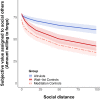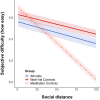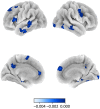Neural responses underlying extraordinary altruists' generosity for socially distant others
- PMID: 37416875
- PMCID: PMC10321390
- DOI: 10.1093/pnasnexus/pgad199
Neural responses underlying extraordinary altruists' generosity for socially distant others
Erratum in
-
Correction to: Neural responses underlying extraordinary altruists' generosity for socially distant others.PNAS Nexus. 2023 Sep 18;2(9):pgad304. doi: 10.1093/pnasnexus/pgad304. eCollection 2023 Sep. PNAS Nexus. 2023. PMID: 37727861 Free PMC article.
Abstract
Most people are much less generous toward strangers than close others, a bias termed social discounting. But people who engage in extraordinary real-world altruism, like altruistic kidney donors, show dramatically reduced social discounting. Why they do so is unclear. Some prior research suggests reduced social discounting requires effortfully overcoming selfishness via recruitment of the temporoparietal junction. Alternatively, reduced social discounting may reflect genuinely valuing strangers' welfare more due to how the subjective value of their outcomes is encoded in regions such as rostral anterior cingulate cortex (ACC) and amygdala. We tested both hypotheses in this pre-registered study. We also tested the hypothesis that a loving-kindness meditation (LKM) training intervention would cause typical adults' neural and behavioral patterns to resemble altruists. Altruists and matched controls (N = 77) completed a social discounting task during functional magnetic resonance imaging; 25 controls were randomized to complete LKM training. Neither behavioral nor imaging analyses supported the hypothesis that altruists' reduced social discounting reflects effortfully overcoming selfishness. Instead, group differences emerged in social value encoding regions, including rostral ACC and amygdala. Activation in these regions corresponded to the subjective valuation of others' welfare predicted by the social discounting model. LKM training did not result in more generous behavioral or neural patterns, but only greater perceived difficulty during social discounting. Our results indicate extraordinary altruists' generosity results from the way regions involved in social decision-making encode the subjective value of others' welfare. Interventions aimed at promoting generosity may thus succeed to the degree they can increase the subjective valuation of others' welfare.
Keywords: altruism; neuroeconomics; prosocial choice; social discounting; social valuation.
© The Author(s) 2023. Published by Oxford University Press on behalf of National Academy of Sciences.
Figures






References
-
- de Waal FBM. 2008. Putting the altruism back into altruism: the evolution of empathy. Annu Rev Psychol. 59:279–300. - PubMed
-
- Batson CD. 2011. Altruism in humans. Oxford (UK): Oxford University Press.
-
- Marsh AA. 2019. The caring continuum: evolved hormonal and proximal mechanisms explain prosocial and antisocial extremes. Annu Rev Psychol. 70:20–25. - PubMed
-
- Marsh AA. 2016. Neural, cognitive, and evolutionary foundations of human altruism. Wiley Interdiscip Rev Cogn Sci. 7:59–71. - PubMed
-
- Miller DT. 1999. The norm of self-interest. Am Psychol. 81:5–16. - PubMed
LinkOut - more resources
Full Text Sources

